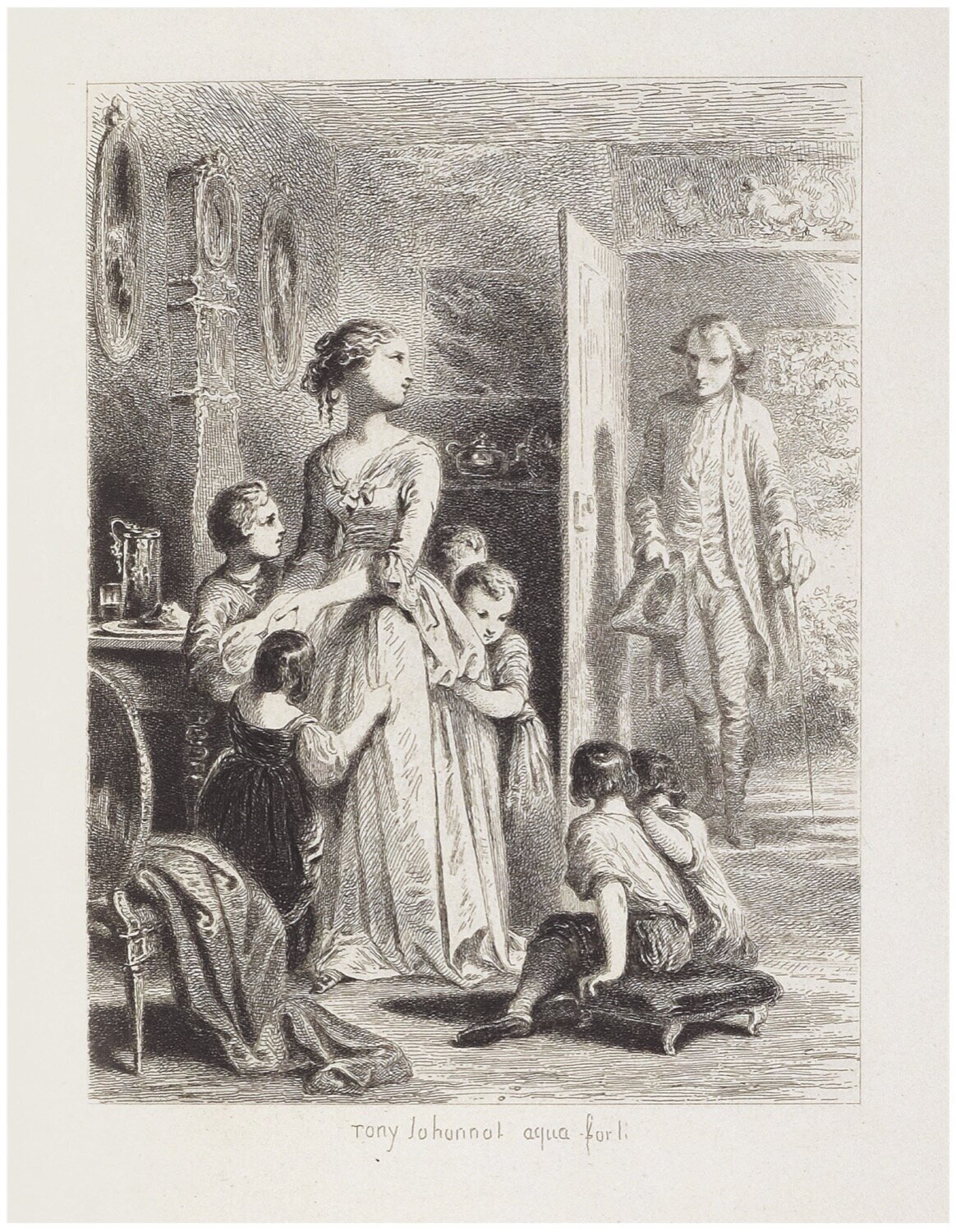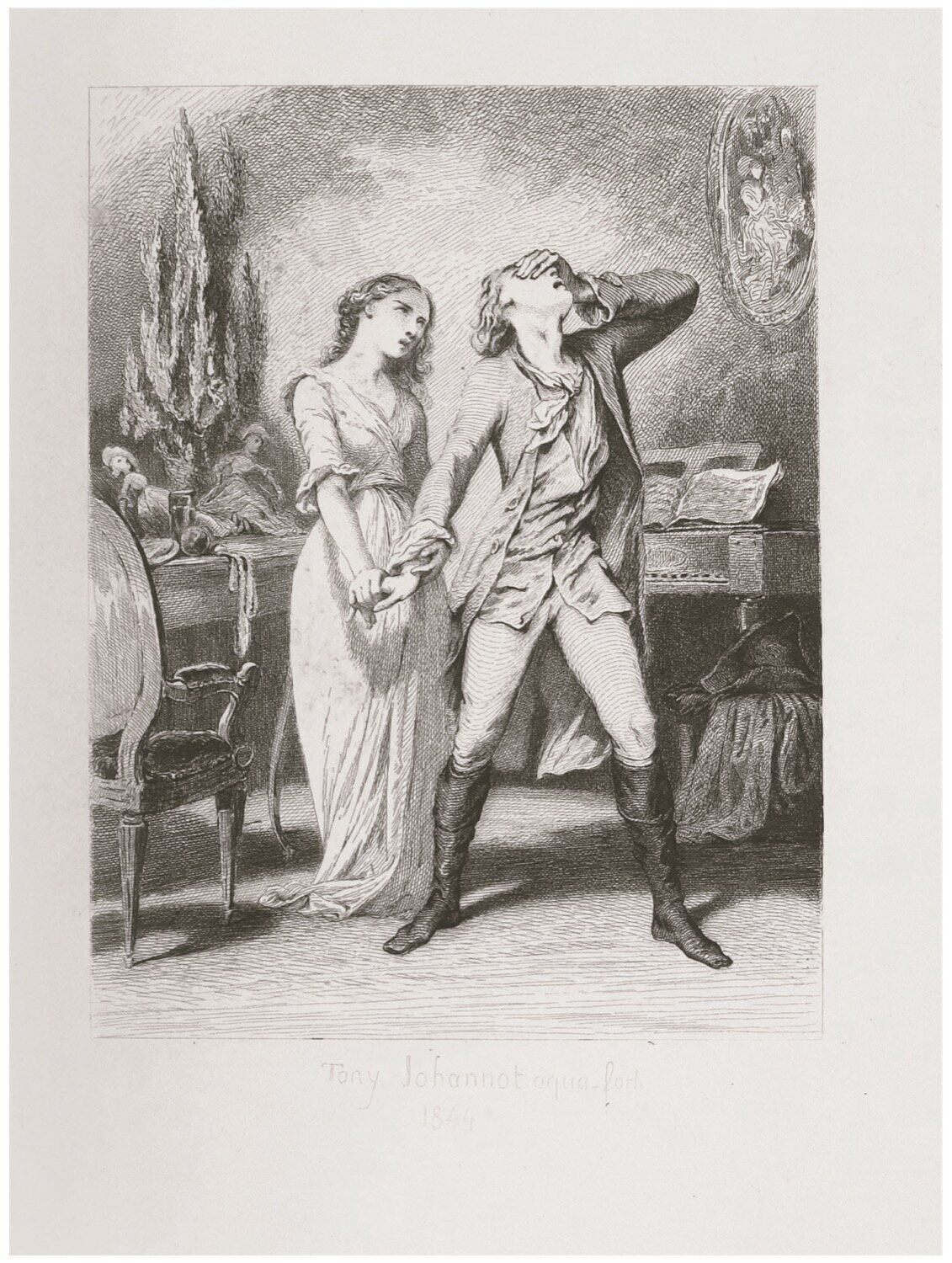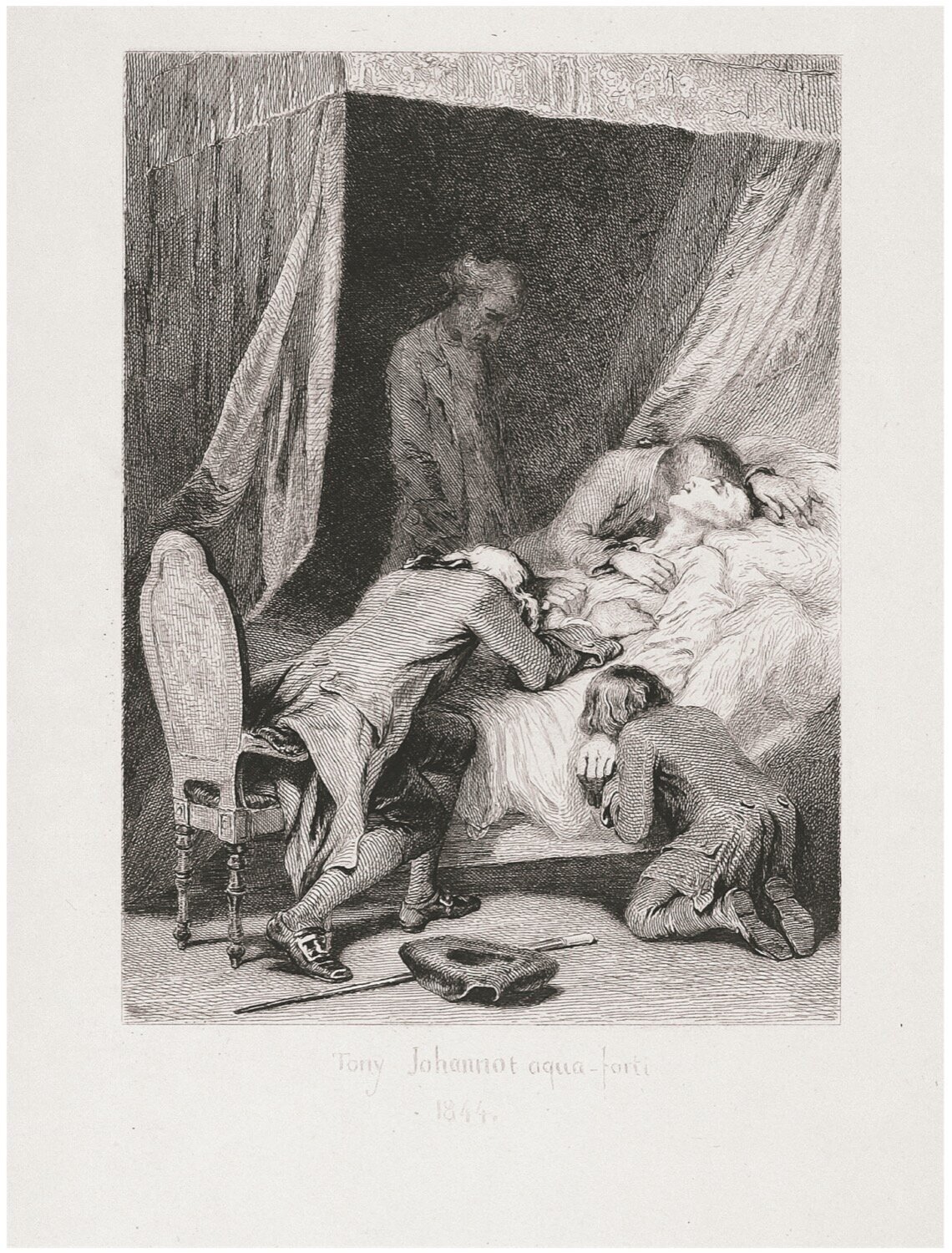XII. Goethe
XII. Goethe as a Starting Point
Faust
The French view of the German Romantic was decisively shaped by an edition of Goethe's Faust with lithographs by Eugène Delacroix (1828). His manner of depiction was revolutionary, especially in contrast to the German pictorial tradition of Peter von Cornelius and Moritz Retzsch, which was steeped in Biedermeier sentimentality. Delacroix placed the gloomy and demonic at the center of his pictorial statements, and his depiction of Mephisto, to this day, remains the iconographic standard. After seeing two early proofs, Goethe himself sensed that Delacroix was the right artist to "create images that no one could have imagined".
In only a few rare copies, the plates appear on China paper in a variety of tints: light and medium gray, straw, pink, and three different shades of blue. The colour assignment varies in the different copies; here we see the copy from the collection of Pierre-Antoine Berryer in a mosaic binding by Dunezat [no. 267]. An album of only the lithographs printed on even larger white laid paper [no. 268], makes the illustrations appear even more monumental.
In 1847, Tony Johannot created nine etchings for a new Faust edition, considered by Johannot's biographer Aristide Marie to be "the best inspired by Goethe's masterpiece", with the definitive depictions of Faust, Gretchen and Mephisto. Eugène Paillet's copy [no. 269], which also includes the proof engravings, was additionally adorned with further suites by Moritz Retzsch, Wenzel Pobuda, and Adolph Lalauze.
The Sufferings of Young Werther
By 1845, Johannot had already illustrated two editions of Goethe's The Sufferings of Young Werther (Hetzel and Crapelets). Compared to the theatricality of the 1825 edition, which included four etchings after René Théodore Berthon [no. 261], Johannot’s illustrations favoured the romantic-contemplative depictions of domestic life. But while the Hetzel edition shows the characters in costumes and interiors that correspond to the novella’s setting in the 18th century, the Crapelets edition updates the temporal setting to the late Biedermeier period.
Of the copies of the Crapelet edition in this display, one belonged to Princess Clémentine d'Orléans, the youngest daughter of King Louis-Philippe I, and it includes four complete sets of the plates, each representing a different stage of printing, as well as 27 additional engravings, including six portraits of Goethe [no. 265]. The second copy, in a binding by Trautz-Bauzonnet [no. 266], belonged to the edition’s translator, Henri-Noël-François Huchet de la Bédoyère. It is printed on vellum with an exceptionally wide margin, and features not only the engravings in three stages, but also four of the original wash drawings by Tony Johannot.
In its entirety, this Goethe ensemble is an outstanding example of the Franco-German cultural exchange that spans the arc from the 18th to the late 19th centuries, from Sturm und Drang to Romanticism, and from Biedermeier to historicism.
![A rare copy with plates on a variety of tinted China paper in a variety of tints, in a mosaic binding by Dunezat [no. 267]](https://images.squarespace-cdn.com/content/v1/5b02a5098ab7225ab8d3a10c/1594143343446-OH9QI2JVG07FZ5ADAS25/267b.jpg)
![A rare copy with plates on a variety of tinted China paper in a variety of tints, in a mosaic binding by Dunezat [no. 267]](https://images.squarespace-cdn.com/content/v1/5b02a5098ab7225ab8d3a10c/1594143421291-9XJIVJWBCX024J15Q2SD/267c.jpg)
![A rare copy with plates on a variety of tinted China paper in a variety of tints, in a mosaic binding by Dunezat [no. 267]](https://images.squarespace-cdn.com/content/v1/5b02a5098ab7225ab8d3a10c/1594143447005-S67MRM4VWDXVQVJ1B5A3/267d.jpg)
![A rare copy with plates on a variety of tinted China paper in a variety of tints, in a mosaic binding by Dunezat [no. 267]](https://images.squarespace-cdn.com/content/v1/5b02a5098ab7225ab8d3a10c/1594143351148-L9M38FAYX8UUAEVVK7PV/267e.jpg)
![A rare copy with plates on a variety of tinted China paper in a variety of tints, in a mosaic binding by Dunezat [no. 267]](https://images.squarespace-cdn.com/content/v1/5b02a5098ab7225ab8d3a10c/1594143343140-CTPA4IU59XDG0KBOD26S/267a.jpg)
![An album of the lithographs only, printed on large laid paper [no. 268]](https://images.squarespace-cdn.com/content/v1/5b02a5098ab7225ab8d3a10c/1594143645342-Y0X6DXE2KLIYRXECJBIZ/268a.jpg)
![An album of the lithographs only, printed on large laid paper [no. 268]](https://images.squarespace-cdn.com/content/v1/5b02a5098ab7225ab8d3a10c/1594143645771-LEGK10T8LDTHNE5L24YJ/268b.jpg)
![Eugène Paillet's copy of the 1847 edition with etchings by Johannot, with proofs and further suites by Moritz Retzsch, Wenzel Pobuda, and Adolph Lalauze [no. 269]](https://images.squarespace-cdn.com/content/v1/5b02a5098ab7225ab8d3a10c/1594143811411-QY9SEAZ5OAEA7GLWZ95E/269a.jpg)
![Eugène Paillet's copy of the 1847 edition with etchings by Johannot, with proofs and further suites by Moritz Retzsch, Wenzel Pobuda, and Adolph Lalauze [no. 269]](https://images.squarespace-cdn.com/content/v1/5b02a5098ab7225ab8d3a10c/1594143811916-KQQBOLTG4LUW8OUXJI47/269b.jpg)



![An example of the 1825 edition, which included four etchings after René Théodore Berthon [no. 261]](https://images.squarespace-cdn.com/content/v1/5b02a5098ab7225ab8d3a10c/1594142669355-EPYG5PUHUG5XV9EX1SF0/261.jpg)
![The copy once owned by Henry Houssaye and Armand Ripault, bound in the morocco publisher’s binding [no. 263]](https://images.squarespace-cdn.com/content/v1/5b02a5098ab7225ab8d3a10c/1594142599873-6L73L3R3JO7GR052QPJS/263.jpg)
![An example of the Crapelet edition, with four complete sets of the plates [no. 265]](https://images.squarespace-cdn.com/content/v1/5b02a5098ab7225ab8d3a10c/1594142893170-ODVSB9P7W8GTCOD3HN5W/265.jpg)
![A copy in a binding by Trautz-Bauzonnet, printed on vellum with wide margins, featuring the engravings in three stages, and four original wash drawings by Tony Johannot [no. 266]](https://images.squarespace-cdn.com/content/v1/5b02a5098ab7225ab8d3a10c/1594143029115-OJCKBBR6H77ZZ0TMTTBB/266b.jpg)
![A copy in a binding by Trautz-Bauzonnet, printed on vellum with wide margins, featuring the engravings in three stages, and four original wash drawings by Tony Johannot [no. 266]](https://images.squarespace-cdn.com/content/v1/5b02a5098ab7225ab8d3a10c/1594143032265-DFJMWD7ZRALRPQ5HZO29/266c.jpg)
![A copy in a binding by Trautz-Bauzonnet, printed on vellum with wide margins, featuring the engravings in three stages, and four original wash drawings by Tony Johannot [no. 266]](https://images.squarespace-cdn.com/content/v1/5b02a5098ab7225ab8d3a10c/1594143200185-D69RLP02LEZBH7QNCQI7/266d.jpg)
![A copy in a binding by Trautz-Bauzonnet, printed on vellum with wide margins, featuring the engravings in three stages, and four original wash drawings by Tony Johannot [no. 266]](https://images.squarespace-cdn.com/content/v1/5b02a5098ab7225ab8d3a10c/1594143028618-37WZL546ZJ5J6KEL3LSS/266a.jpg)